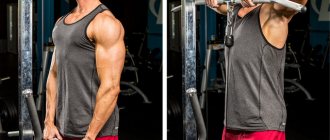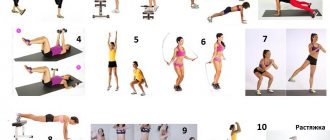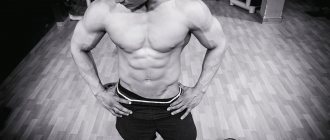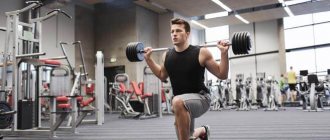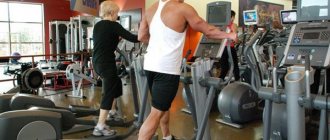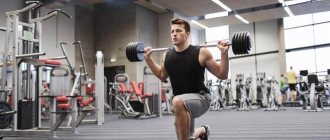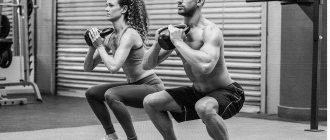Split training (English split - to split, split) is a method of constructing sports activities, which involves dividing the training program into parts and performing them on different days. This principle is used in bodybuilding and helps the athlete to load the necessary muscles well in a short period of time.
Advantages of the technique:
- Accented elaboration . Each lesson is aimed at developing a selected muscle group, which allows you to gradually increase weight loads.
- Optimal rest . Thanks to the separate principle, the risk of overtraining is reduced, and the muscles have enough time to recover.
- Increasing the intensity of classes . Using the split method, the athlete gets the opportunity to conduct short but effective workouts.
The use of split programs contributes to the development of strength characteristics and stimulates hypertrophy of muscle fibers.
Difference from other methods
Let's look at two popular training systems and compare them with splits.
Full body
Whole body workout. It is a program in which each session is aimed at developing the main muscle groups.
The advantages of the technique include comprehensive strengthening of the muscles and ligaments of the body.
The disadvantages are that they are not suitable for volumetric strength training.
The difference between the systems: thanks to the accentuated training of muscles and a long recovery period, split training for mass, in contrast to the “full body”, allows the athlete to gradually increase the load each session, stimulating the muscles to grow.
Experienced fitness trainers recommend full body to beginner athletes in order to strengthen the muscle frame and ligaments and prepare the body for more serious loads. And, conversely, trained athletes and professionals engage in separate split training.
Circuit training
It is based on intense exercises performed in a circle, with minimal breaks. Circuit training is recommended for those who want to have a toned, functional body with minimal body fat.
The technique is designed to increase endurance and lose weight.
Cyclic exercises allow you to harmoniously strengthen your muscles.
The downside of such training and the main difference from split training is the inability to build large muscle volumes and strength.
Beginners and girls can start with low-intensity circuit exercises so as not to overload the heart muscle. Professional athletes, as a rule, use such training to work out the relief and reduce subcutaneous fat.
Types of goals
Main goals that can serve as the foundation of your system:
- gaining muscle mass
- weight loss
- figure correction
- development of physical qualities (coordination, endurance, strength, flexibility, agility)
- recovery, rehabilitation
- learning a new skill
- creation of muscle relief
- maintaining current results
After you decide on the main goal, you should choose the place where your dream will come true! If you have no previous experience or your experience is still small, feel free to choose a fitness club that has all the services you need. No one has canceled variety: depending on your determination, you can add combinations of several types of load that complement each other, which will shorten the time to achieve what you want.
Recommendations for different body types
Read more about this classification in a separate material on somatotypes.
Ectomorph
Thin people with thin bones, underdeveloped muscle corset and low subcutaneous body fat:
- Nutrition . To gain weight, you need a high-calorie diet (more than 3300 kcal/day). The basis of the menu should be “complex” carbohydrates: cereals, durum wheat pasta, whole grain bread. Proteins and fats should be consumed in approximately equal proportions. You need to eat several times a day. If you can’t increase your body weight, you can use sports nutrition: creatine, gainers.
- Physical exercise . For ectomorphs, it is not advisable to get involved in aerobic training. Classes should be based on basic elements (deadlift, bench press, squat). Exercises should be distributed over 3 sessions per week, that is, the preferred type of training for the ectomorphic type is a three-day split with pauses of 1-2 days.
Mesomorph
Physically developed, strong people, most predisposed to strength training:
- Nutrition . The basis of a mesomorph’s diet should be protein foods: red meat, poultry, fish, cottage cheese. Menu calorie content: 3200–3400 kcal/day. People with a mesomorphic body type need to reduce carbohydrates and fats in their diet. Recommended supplements: vitamins, protein mixtures.
- Physical exercise . The basis of mesomorph training is the same strength elements: squats, bench presses, deadlifts. Exercises should be divided into 3 sessions. At the same time, a three-day split training for men should be strength training, that is, in each approach you need to select the weight so that failure is felt at 7-8 repetitions. In addition to the basic elements, you should select “complementary” exercises that promote maximum blood supply to the muscles. Rest between classes - 1-2 days.
Endomorph
Large-boned people with a high percentage of subcutaneous fat and weak, undeveloped muscles:
- Nutrition . The diet should be divided into small portions. Low calorie content: no more than 1800 kcal/day. The basis of the menu should be lean proteins (chicken fillet, eggs without yolks, fish, low-fat cottage cheese) and vegetable fiber (fruits, vegetables, herbs). The amount of carbohydrate food should be reduced to 15% of the daily value. Recommended supplements: vitamins, fat-burning complexes, high-quality protein isolates.
- Physical exercise . The training program should be drawn up for three days a week. It is recommended that these classes be carried out in an aerobic mode, aimed at burning fat and tightening the body (for example, aerobics, circuit training). If an athlete wants to train using the split method, the weights should be selected so that the approaches are multi-repetitive (15–20 times). The break between classes is 1 day. During recovery periods, you can do cardio exercises outside (for example, cycling or a light jog in the park).
As a rule, mixed body types predominate among people, for example, ectomorph-mesomorph. To more accurately determine your body type and create an effective training program, we recommend contacting a professional fitness trainer.
By the way, split training for girls is not much different from men’s; adjustments are made only for the weight of the equipment.
Number of repetitions
The number of repetitions of a particular exercise in your cycle depends on the chosen goal.
What are the ground rules? Everything is very simple. The optimal amount for fat burning would be 8-15 repetitions per set. Research shows that performing repetitions in this range stimulates the effective production of fat-burning hormones. At first glance, there is a large spread in the interval, but this is where the values of the weights you use and your level of training come into play. By sticking to the interval, you can change the number of repetitions from workout to workout, for example:
- 8-10 reps per set
- 10-12 reps per set
- 12-15 reps per set
Whichever option you choose will help you burn fat effectively, so for beginners we recommend starting in that order.
Approximately every few weeks, you can increase the interval, listening to your feelings. In a training program aimed at increasing muscle mass, a slightly different principle applies. There is an opinion that to build muscle mass, repetitions of up to 8-12 times per approach are required, but this is not entirely true.
The revolution was made by the English bodybuilder and surgeon Ian McQueen, who in his work recommended performing a much higher number of repetitions. Many studies have been carried out analyzing indicators, during which it turned out that hypertrophy of the muscular corset is ensured by progressively increasing working weight. In this case, up to 4-6 repetitions per approach will be enough. Like this!
Fitness consultants have come up with the following scheme in tandem with the Men's Health publication:
- Day 1 – 5 reps per set
- Day two – 15 reps per set
- Day three – 10 reps per set
Arizona State scientists found a clear improvement in training performance, nearly doubling, among those who varied the number of reps per set on different days over the course of one week compared to those who did the same number of reps per set.
Remember - there are no repetitions that are not beneficial! It is no coincidence that their number is prescribed in the training program. The muscles adapt to the type of load applied depending on the number of repetitions. Keeping this in mind, create a strategy that best suits your goals. If you decide to change the number of repetitions, you will not see changes immediately, but they are guaranteed to happen.
Let's discuss the number of repetitions:
- The minimum number of repetitions (from 1 to 5 times) is necessary for the trainee when it is necessary to take the maximum possible working weight of the weight, while the load on the muscles is maximum. Muscle fibers consist of contractile filaments - myofibrils, and maximum load increases the number of myofibrils. The minimum number of repetitions is excellent for building strength and increasing the volume of muscle tissue, which is also reflected in the visual characteristics. This is how we work with myofibular hypertrophy.
- A high number of repetitions (11 or more) forces the muscle fibers to contract for a long time. What does this give to the athlete? The number of mitochondria in muscle fibers increases, which are producers of energy spent on burning fat and working on the principle “the more, the better.” This increases a person’s endurance and improves the health of the cardiovascular system.
- The standard number of repetitions (from 6 to 10 times) is suitable for those trainees who are faced with the task of working with moderate tension in the muscle fibers in a limited period of time. We can say that this technique is a symbiosis of the two previous ones. It is good because it allows you to increase muscle endurance while increasing strength. If you want to find a balance between these two criteria, then work in the standard frequency range. But working with so many repetitions has its own nuances. Consistent, regular use of this technique will not allow you to maximally load your muscles and subject them to stress as with high reps. Our recommendation is to use all three ranges.
Two-day split
The technique is suitable for all interested athletes who do not use anabolic steroids. It is known that muscles grow in volume with a constant increase in weight loads and quality rest. But many athletes, having read “programs from champions” on the Internet, try to repeat the success of bodybuilding stars, completely forgetting that all professionals use expensive pharmacological support.
Naturally, the “natural” muscles do not have time to recover from such training, and the results leave much to be desired. Therefore, experienced mentors recommend that everyone who practices “purely” use two-day splits. These programs allow you to get quality rest between workouts, which has a positive effect on increasing strength and mass.
Principles of compilation:
- All muscles should be divided into two large groups.
- Exercises that load the muscles of the back and lower back should be spread out on different days.
- Elements that create stress on the shoulder joints should also be distributed among individual workouts.
Example program
1 lesson:
- Pull-ups on the bar: 3x10.
- Head pull in the simulator: 3x15.
- Deadlift: 3x8.
- Crossover waist pull: 3x15.
- Abduction in the butterfly machine: 3x10.
- Seated chest press: 3x10.
- Dumbbell lateral raises: 3x12.
- Close grip barbell press: 2x8.
- French press: 2x12.
Lesson 2:
- Barbell squats: 3x8.
- Lunges with an empty bar on the shoulders: 2x10.
- Calf raises: 3x20.
- Bench chest press: 3x8.
- Dips: 2x12.
- Mixing in a butterfly simulator: 3x12.
- Dumbbell raises on a horizontal bench: 3x10.
- Curling arms in the Scott machine: 3x12.
- Crossover biceps curl: 3x15.
Work your abdominals at the end of your workouts. The pause between classes is 2–3 days.
Three day split
The most common scheme. The 3-day split is used by both beginners and professionals. With this type of training, the muscles receive an accentuated load and sufficient time for recovery.
Principles:
- Basic elements are distributed over three workouts.
- In addition to strength training, the plan includes “finishing” exercises.
Example program
1 lesson:
- Bench press: 4x8.
- Mixing in a butterfly simulator: 3x12.
- Dips: 3x10.
- Lying crossover raise: 3x10.
- Incline chest press: 3x10.
- French bench press: 3x12.
- Crossover triceps extension: 3x12.
- Reverse push-ups from a bench: 3x12.
Lesson 2:
- Pull-ups on the bar: 4x8-10.
- Head pull while sitting in a crossover: 3x12.
- Deadlift: 3x8.
- Bent-over dumbbell raises: 2x10.
- Chest row with a wide grip on the lower block: 3x12.
- Crossover biceps curl: 3x12.
- Hammer grip dumbbell curls: 2x12.
- EZ-bar biceps curl: 3x12.
Lesson 3:
- Squats: 4x8.
- Hack squats: 3x10.
- Extension in the quadriceps machine: 2x12.
- Lying flexion in the hamstring machine: 2x12.
- Raises in the calf machine: 3x20.
- Smith overhead press: 3x10.
- Standing dumbbell press: 3x10.
- Wide grip barbell row to the chin: 3x10.
Strengthen your abdominal muscles at the end of the session. Between workouts, leave a free day for rest.
Nutrition and training program
Nutrition is as important as the chosen loads - by the way, we have good articles about this. But I want to say something briefly. Firstly, protein plays the role of the main building material for muscles. As for carbohydrates, here you need to look at your needs, the main thing is not to give them up at all. Carbohydrates are energy, it is spent during training! There is an interesting formula, the so-called “five”, which states that every day you need to consume five servings of vegetables and fruits - sources of minerals, vitamins and trace elements that contribute to the gentle restoration of the body. As for drinks, preference is given to water; it is advisable to exclude alcohol from the diet altogether, including because of its calorie content.
Four-day split
This type of training is used by trained athletes when it is necessary to increase the intensity of training. It is not recommended for beginners to practice this split.
The method is based on the same division of large muscle groups and working them on separate days. There are no fundamental differences from the three-day program. One workout is simply added, into which part of the exercises performed is distributed, for example, for the shoulders and arms.
The schedule can be drawn up in different ways, but the most popular scheme is: Monday, Tuesday - training; Wednesday - break; Thursday, Friday - training; Saturday, Sunday - rest.
Example program
Monday:
- Wide pull-ups: 3x10–12.
- Deadlift: 3x10.
- Hyperextensions: 3x12.
- Bent-over barbell row from the floor: 3x10.
- Shrugs with dumbbells: 3x12.
Tuesday:
- Push-ups: 2x12.
- Bench press: 3x10.
- Crossover wiring: 3x12.
- Smith Incline Press: 3x12.
- Push-ups: 3x12.
Thursday:
- Barbell squats: 3x10.
- Hack squats: 3x12.
- Bulgarian lunges: 3x12.
- Hamstrings in the machine: 3x12.
- Working out the calves in the machine: 3x20.
Friday:
- Narrow chest press in Smith: 3x12.
- Reverse grip pull-ups: 3x10–12.
- Military seated press: 3x12.
- Smith overhead press: 3x12.
- Breeding in the “butterfly” simulator: 3x12.
Work your abdominal muscles at the end of each session. Before the basic elements, perform warm-up approaches.
Five day split
The most effective option for dividing exercises. It is intended only for trained athletes who have experience training in three- and four-day programs.
The principle of construction is to work out each major muscle group on a separate day. When drawing up a training plan, you should correctly distribute the loads so as not to overtrain any part of the body. For example, after working out the chest, it is not recommended to do a shoulder exercise the next day, since all kinds of presses for the pectoral muscles actively involve the anterior and middle deltoids.
Example program
Monday - back:
- Deadlift: 3x8.
- Bent-over dumbbell rows: 3x12.
- T-bar lift: 3x10.
- Shrugs with dumbbells: 3x12.
- Hyperextensions with weights: 3x12.
Tuesday - chest:
- Classic bench press: 3x8.
- Dips: 3x12.
- Incline dumbbell press: 3x12.
- Wiring on a horizontal bench: 3x12.
- Wide push-ups from platforms: 3x12.
Wednesday - legs:
- Barbell squats: 3x8.
- Leg press in the simulator: 3x10.
- Lunges with a small bar on the shoulders: 3x12.
- Romanian deadlift: 3x10.
- Standing calf raises: 3x20.
Thursday - shoulders:
- Military bench press: 3x10.
- Smith overhead press: 3x12.
- Lifting dumbbells in front: 3x12.
- Wiring across the sides: 3x12.
- Bent over raises: 3x12.
Friday - hands:
- Close grip bench press: 3x12.
- Scott curls: 3x12.
- French bench press: 3x12.
- Crossover biceps curl: 3x12.
- Dips (elbows - narrow): 3x12.
Work your abdominal muscles 3-4 times a week. To make the split easier, you can move your Saturday rest to Wednesday.
Proper rest
Each muscle group is given a week's rest. When you don't exercise, your muscles grow. In the gym, you destroy muscle fibers, and when you come home, you create the conditions for their self-repair through an optimal diet and rest regime. Therefore, when you purposefully load your chest once every seven days, then during the remaining six these muscles are restored and grown.
Even when you do not perform special exercises for a particular muscle, it still contracts, playing a supporting role when working neighboring groups. For example, by training the shoulder muscles, you also load the pectoral muscles due to their adjacent location and proximity to the attachment points. So in reality the muscles are never idle for a whole week, which is a good thing.
The intensity with which the stabilizer muscle has to strain provokes even greater growth and does not harm the recovery process at all. Excessive rest should be avoided. If you ever visit third world countries, you will be surprised by the number of people with well-developed arm muscles who, nevertheless, have never been to the gym. The muscles of these guys grow due to everyday manual labor and the use of environmentally friendly products.
I'm not advocating this lifestyle, but it's something to keep in mind the next time you want to count calories or start worrying about not getting enough rest or sleep. All that is required of you is not to cheat in training, eat well, do your daily activities, and everything will work out in the best way. So, I have given enough arguments in favor of the split method and listed all the advantages of a three-day training complex. It's time to give you what you came for.
Recommendations for beginners
These tips will help inexperienced athletes get the maximum benefit from their training:
- Don't start bodybuilding straight away with splits. Prepare your muscles and ligaments with circuit training.
- Do not copy the programs of famous athletes. Choose your plan based on your physical fitness and body type.
- Don't overdo isolation exercises. Additional elements do not replace the basic ones.
- Keep an eye on your technique. It is not always possible to increase the load with each workout. It is better to perform the approach with the weight of the previous lesson, but technically correct.
- In the first months of training, do not push your muscles to the limit. Complete the approach before failure occurs.
- Do not delay the duration of the lesson. 50–60 minutes is enough to effectively load the target muscles.
While in the gym, monitor how you feel. If you feel a strong stretch or even more acute pain in the joint, discard the element and replace it with a safe analogue.


